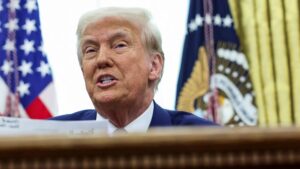# The Shift in Defense Spending: A Closer Look at Trump’s Latest Remarks
In recent news, President Donald Trump has sparked significant discussions regarding the U.S. defense budget. During a press briefing at the White House, he made the provocative statement that the U.S. could potentially halve its defense spending. This remark sent shockwaves through the defense sector, leading to a noticeable drop in major defense stocks, including Lockheed Martin, Northrop Grumman, and General Dynamics.
## Breaking Down Trump’s Comments
While discussing a future conference with leaders from China and Russia, Trump asserted the necessity of reevaluating the nation’s almost $1 trillion military expenditure. He emphasized, “When things settle down, I’m going to meet with China and I’m going to meet with Russia… There’s no reason for us to be spending almost $1 trillion on the military.”
This call for budgetary restraint raises critical questions about the direction of America’s military policy. Trump elaborated on his vision of reallocating these funds towards other pressing societal needs. His statements reflect a blend of optimism for diplomatic discussions and a stark critique of current military expenses.
## Immediate Market Reaction
Investors responded swiftly to Trump’s remarks, resulting in a sharp decline in defense stock prices. For instance:
– **Lockheed Martin** fell by 1.6%
– **Northrop Grumman** dropped 3.4%
– **General Dynamics** lost 2.1%
These movements highlight the stock market’s sensitivity to political rhetoric, especially in sectors as pivotal as defense. Investors and market analysts are closely monitoring these developments as they could significantly shift the landscape for defense contractors, who largely depend on government contracts for revenue.
## The Balancing Act of Defense Spending
Trump’s position on defense spending has been notably inconsistent throughout his campaign and presidency. On one hand, he has designated efforts to cut excessive governmental costs using innovative approaches, such as enlisting tech mogul Elon Musk to streamline operations. Additionally, the urgency to resolve the ongoing conflict in Ukraine has pushed for higher military investments to bolster U.S. weapon sales.
Conversely, Trump continues to emphasize the necessity of a robust military infrastructure, evidenced by his pursuit of ambitious projects like the “Iron Dome of America” missile defense system. His assertion that the U.S. has the “greatest military equipment in the world” further complicates his narrative, presenting a dichotomy between advocating for budget cuts while maintaining military superiority.
## A Year of Contradictions and Opportunities
As we anticipate further developments, it’s clear that Trump’s remarks reflect a broader theme of uncertainty within defense spending dialogues. Analysts, such as Roman Schweizer from TD Cowen, indicate that “right now, people are confused by a number of different crosscurrents” regarding military expenditures. This reflects the complex interplay between political priorities, public sentiment, and the strategic necessities of national defense.
While Trump’s rhetoric may seem at odds with past practices, it is crucial for investors and citizens alike to engage critically with these discussions. The potential for a significant shift in defense spending could herald major changes not only for the defense industry but also for areas such as cybersecurity, technology development, and international relations.
At Extreme Investor Network, we recognize the importance of removing the noise from the narrative and providing clear insights into how such political shifts can impact market trends. As the situation evolves, stay updated with us as we break down these economic implications and help you navigate the complexities of investment in a changing landscape.

